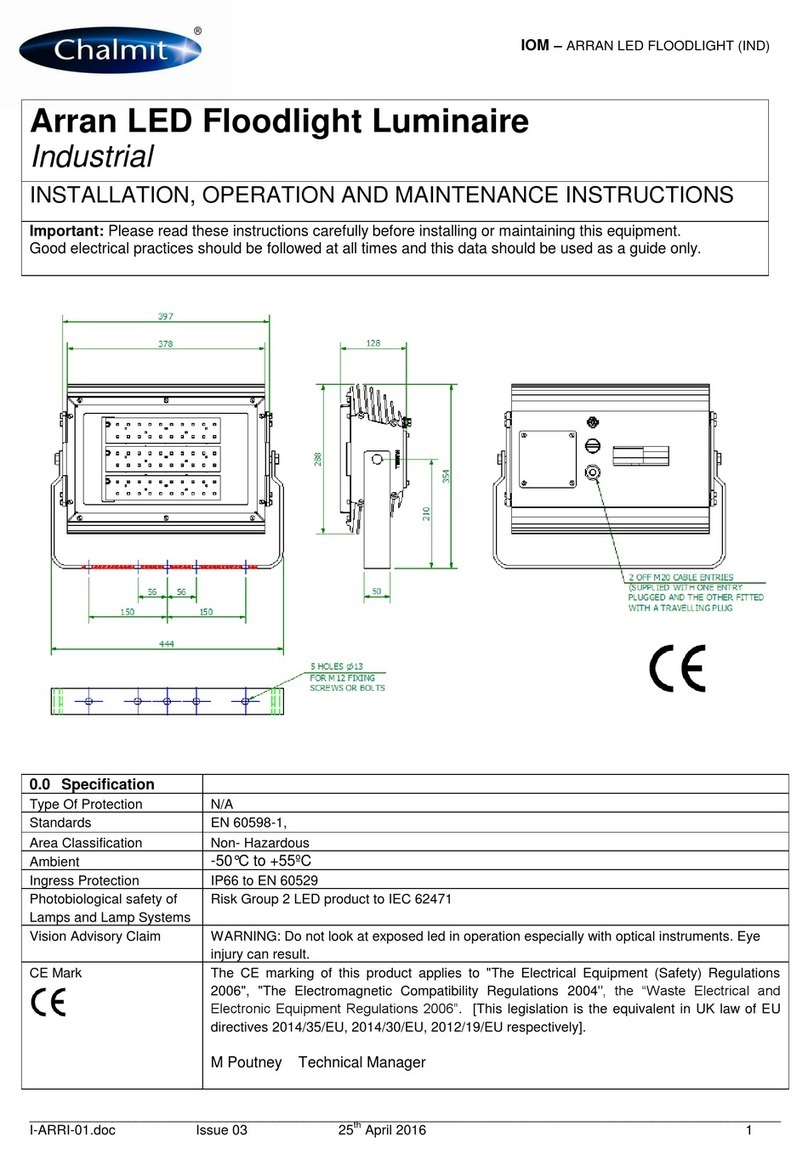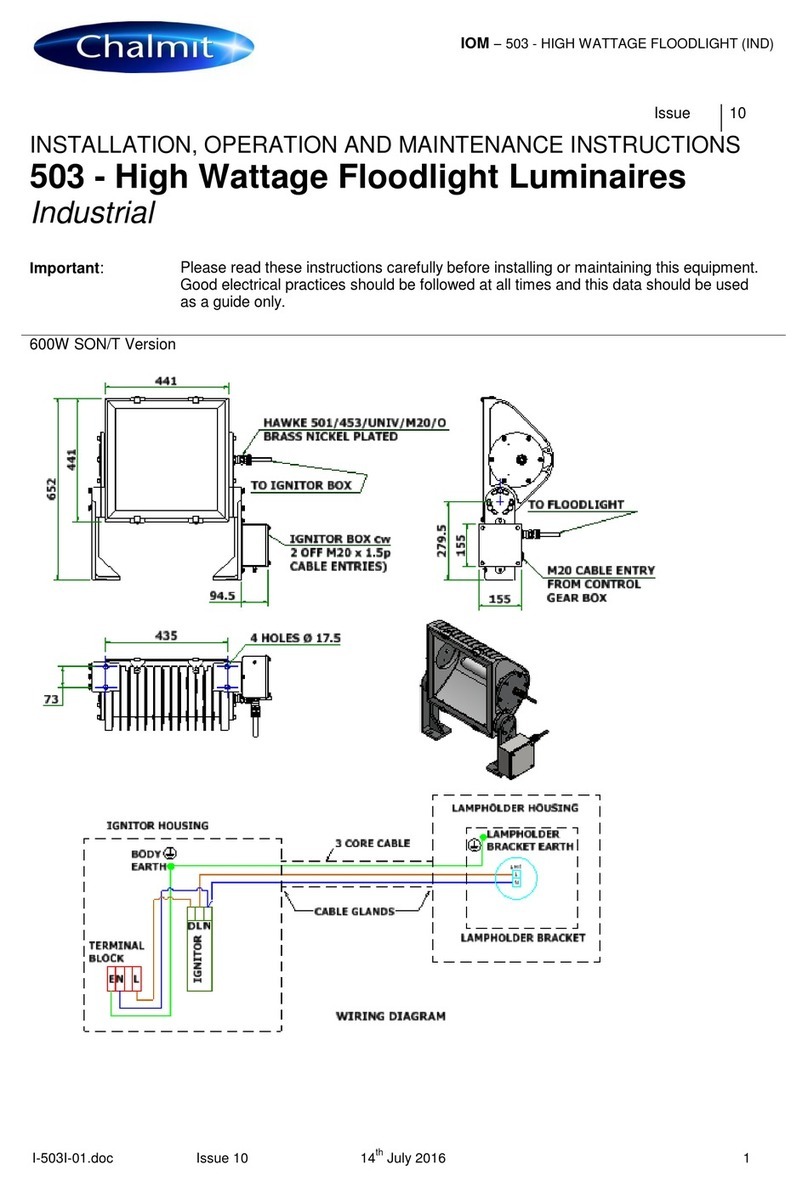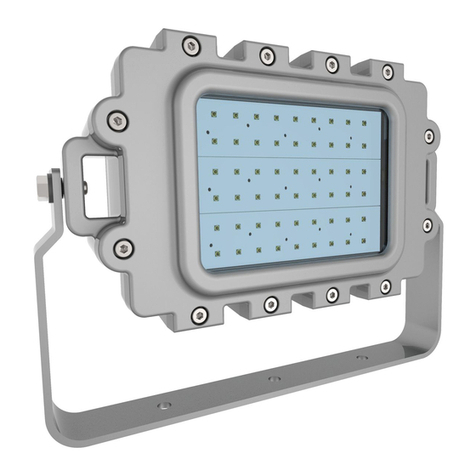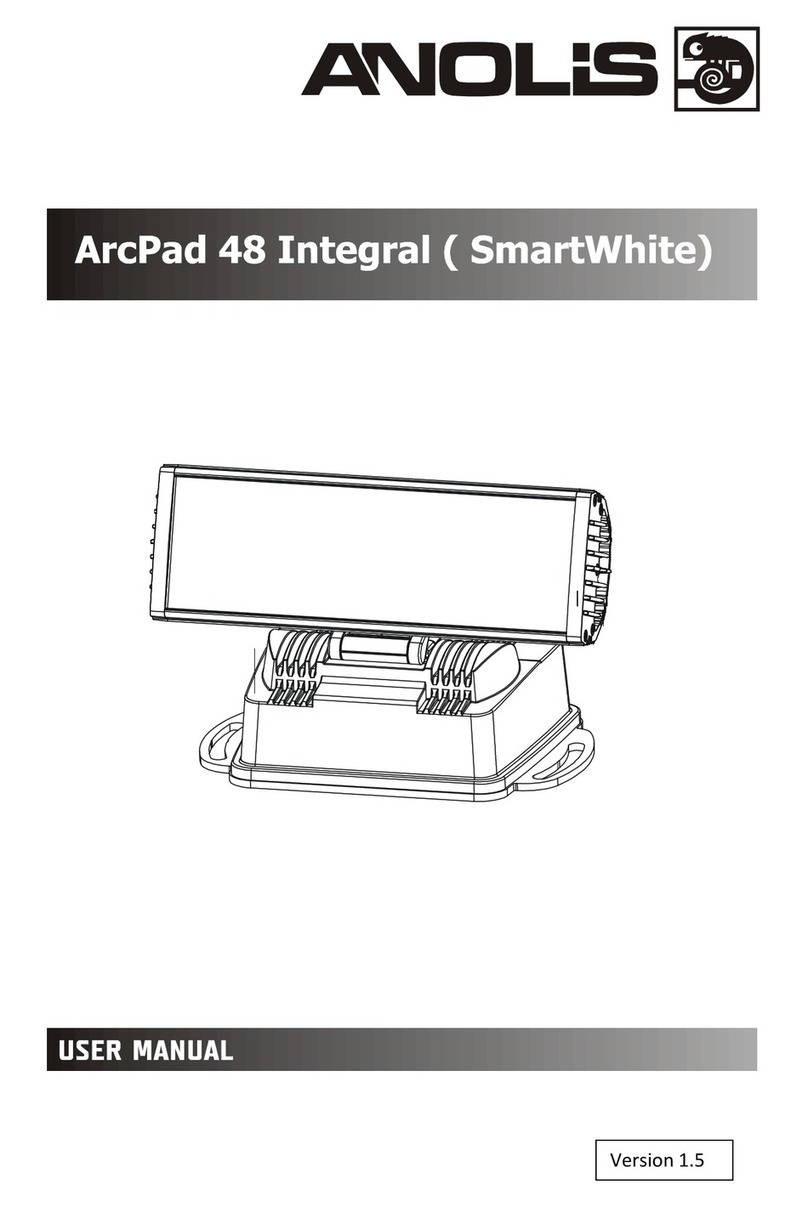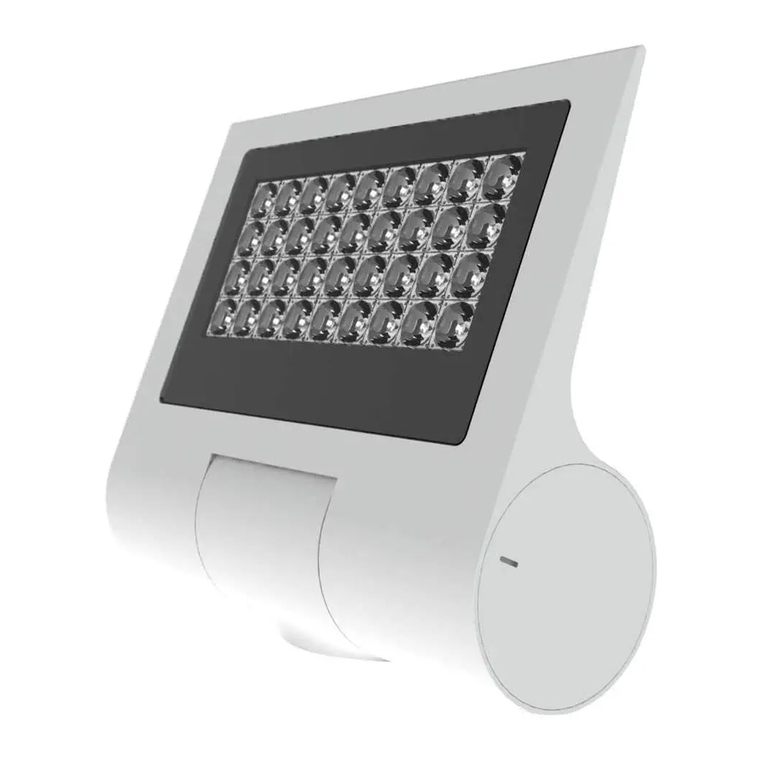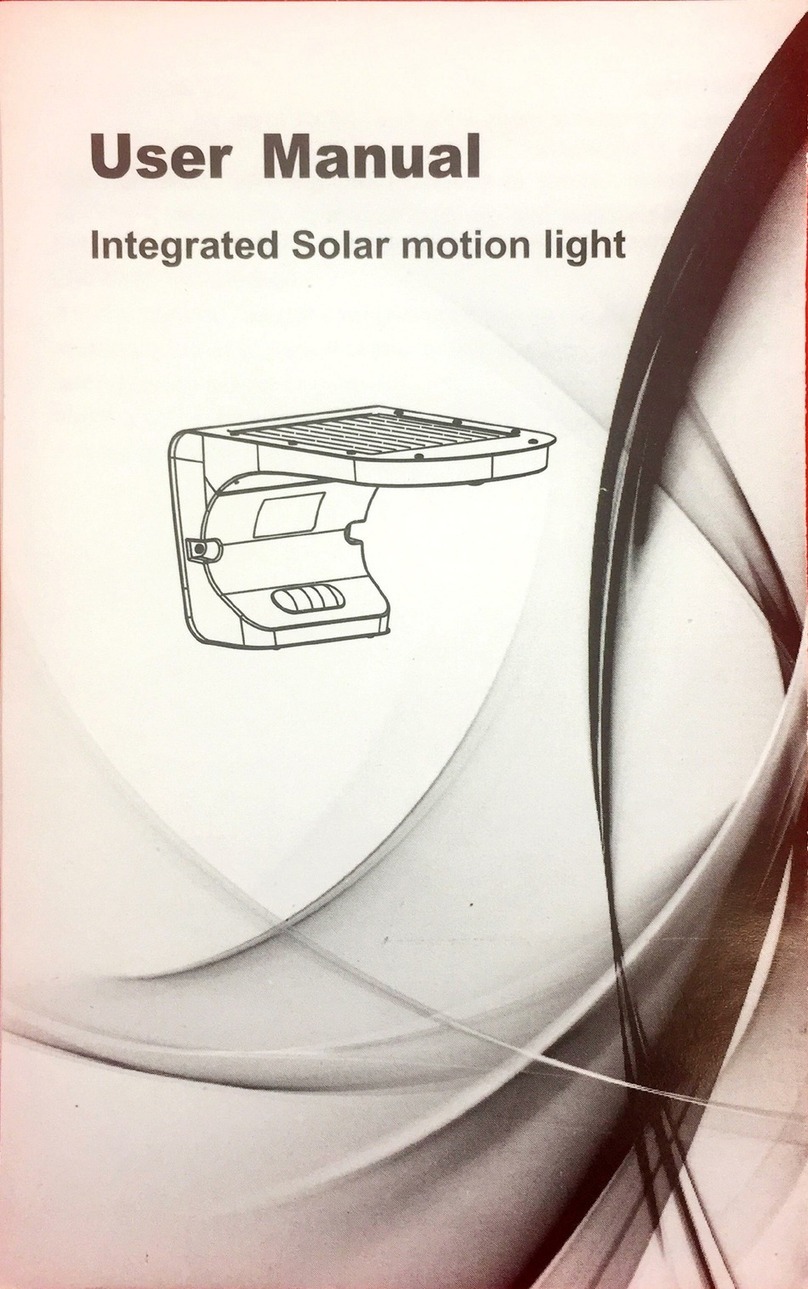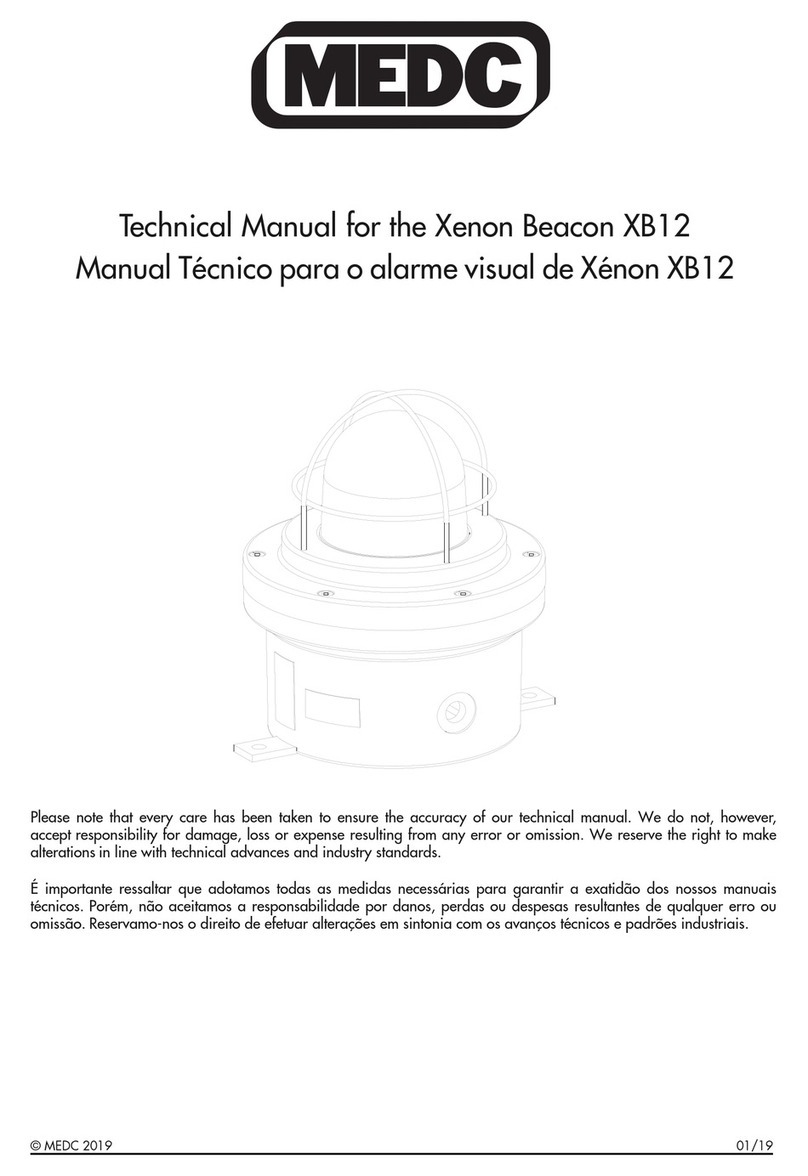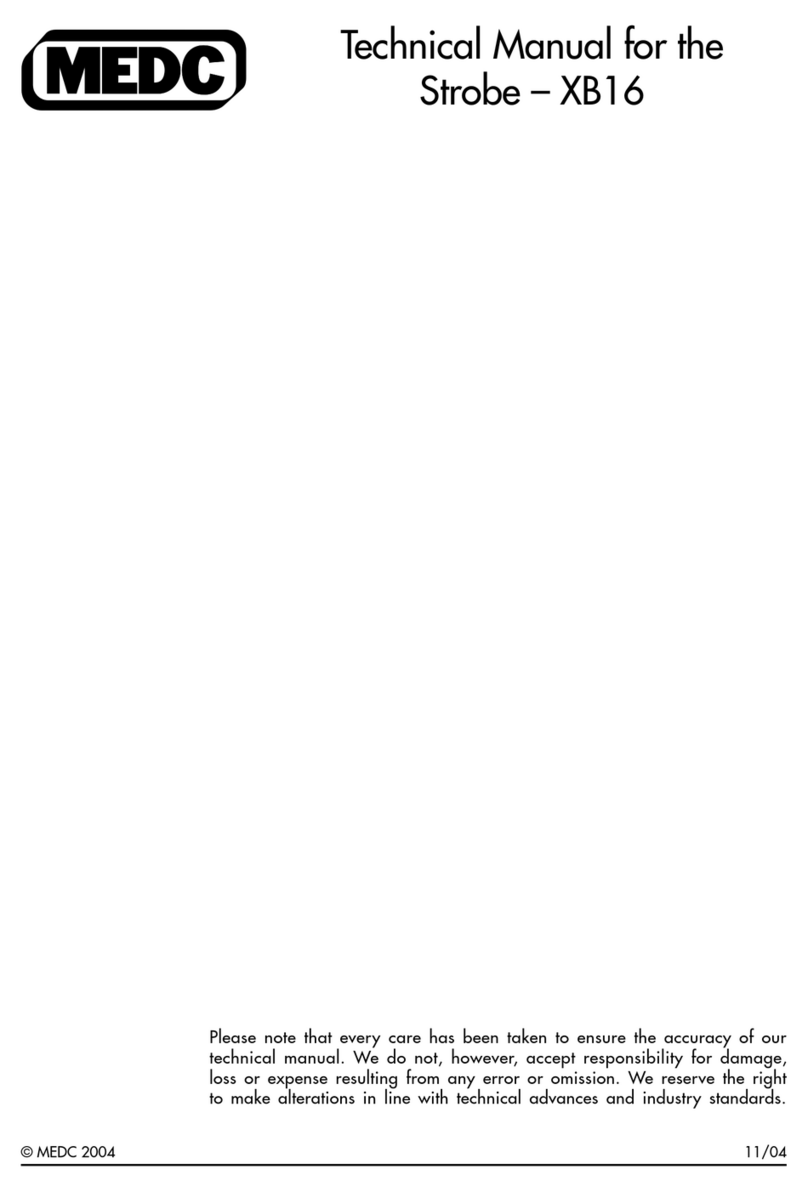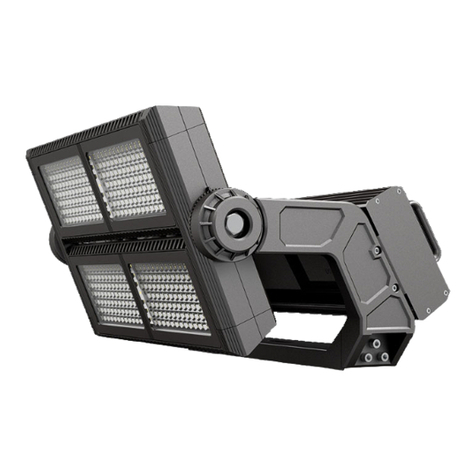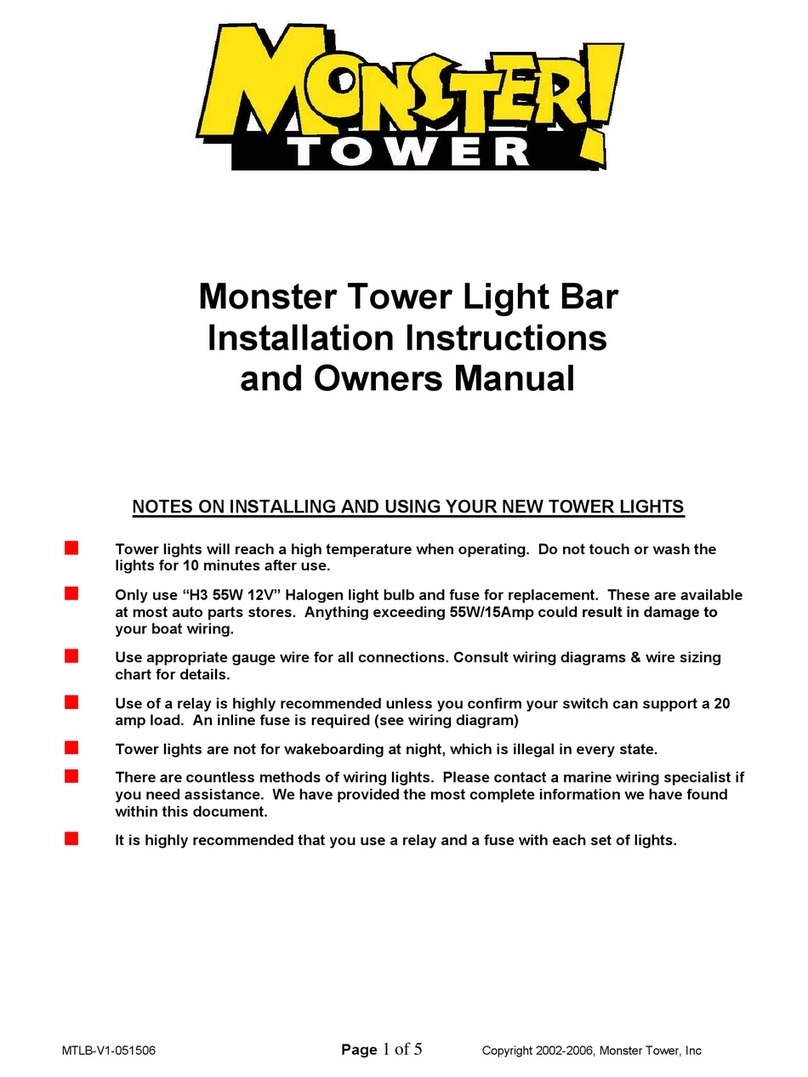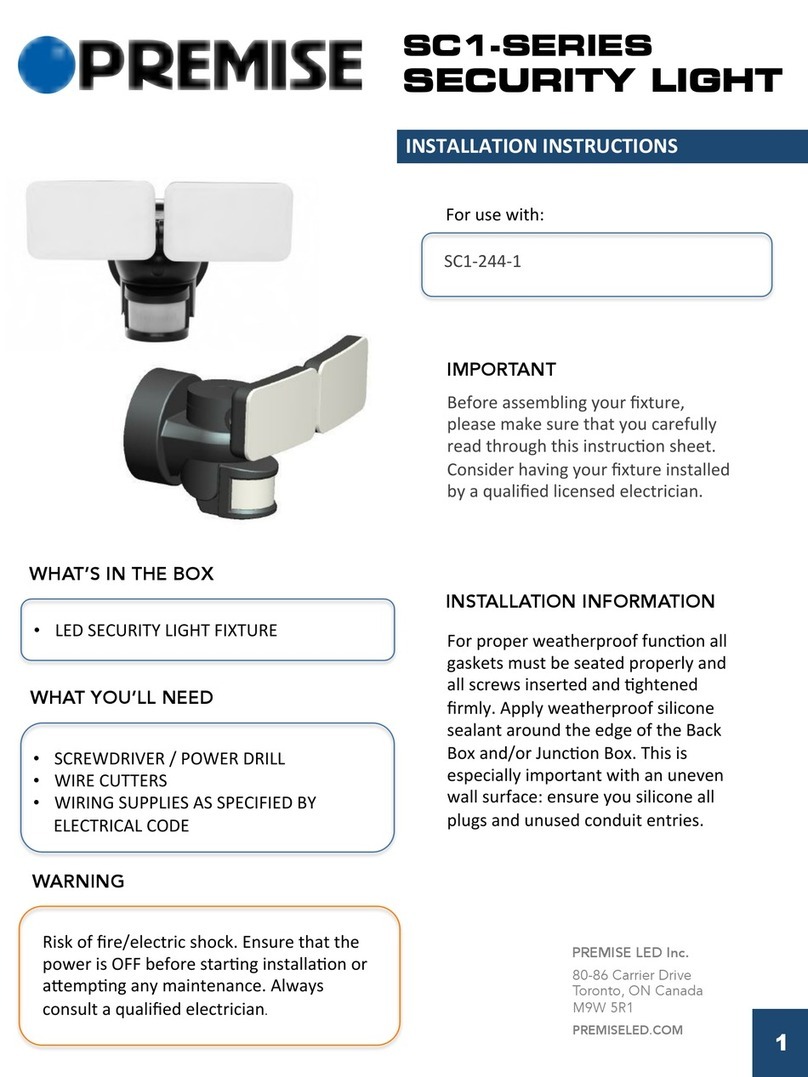Chalmit 800 Series Manual

I-800N-01.doc Issue 16 04/02/2021 1
IOM – 800 SERIES - ZONE 2 FLOODLIGHTS (ATEX, Ex n)
800 Series – Floodlight Luminaires (Ex n)
ATEX
Models 844, 854, and 864
INSTALLATION, OPERATION AND MAINTENANCE INSTRUCTIONS
Important: Please read these instructions carefully before installing or maintaining this equipment.
Good electrical practices should be followed at all times and this data should be used
as a guide only.
A
E
D
F
C C
B
3 HOLES ø13 (854,864)
2 OFF M20 CABLE ENTRIES
DIMENSIONS 844
70W 854
150/250/400W 864
400W
A
B
C
D
E
F
415415
630
150
490
185
260
308
443
75
348
150
175
456
615
150
490
220
250
3 HOLES ø12 (844)

I-800N-01.doc Issue 16 04/02/2021 2
IOM – 800 SERIES - ZONE 2 FLOODLIGHTS (ATEX, Ex n)
0.0 Specification
Type Of Protection Ex nR (restricted breathing)
Protection Standards EN 50021, EN 50281-1-1.
Area Classification Zone 2 areas to EN 60079-10-1, Zone 22 areas to EN 60079-10-2.
Installation EN 60079-14
Certificate Type Examination Certificate BAS98ATEX3378
Equipment Coding Ex nR II T* (T amb see table 1 for details)
ATEX Coding II 3GD T”°C (see table 1)
Ingress Protection IP66/67 to EN 60529
CE Mark
The CE marking of this product applies to "The Electrical Equipment (Safety) Regulations
2006", "The Electromagnetic Compatibility Regulations 2004", the “Waste Electrical and
Electronic Equipment Regulations 2006” and the "Equipment and Protective Systems intended
for use in Explosive Atmospheres Regulations 1996". [This legislation is the equivalent in UK
law of EU directives 2014/35/EU, 2014/30/EU, 2012/19/EU and 2014/34/EU respectively].
The Equipment is declared to meet the provisions of the ATEX directive (2014/34/EU)
by reason of the Type Examination and compliance with the Essential Health and
Safety Requirements.
M Poutney Technical Manager
1.0 Introduction – 800 nR Series Floodlights
The type of protection is Ex nR using a restricted breathing enclosure.
The luminaire is restricted in its mounting position - The beam of the floodlight may be aimed at any angle but
the control gear must always be mounted on or below the axis of rotation of the luminaire.
2.0 Application
The luminaire is designed to be safe in normal operation.
The luminaire should not be used in conditions where there are environmental, vibration or shock conditions
above the normal for fixed installations.
The gaskets should not be exposed to hydrocarbons in liquid or high concentration vapour states.
The luminaire is suitable for applications where Category 3 apparatus is used. The application is for ignitable
gas and dust atmospheres. The type examination does not address suitability for portable applications.
3.0 Installation and Safety
3.1 General
There are no health hazards associated with this product whilst in normal use. However, care should be
exercised during the following operations. Installation should be carried out in accordance with BS EN60079-14
or the local hazardous area code of practice, whichever is appropriate.
The luminaires are Class 1 and should be effectively earthed.
Certification details on the rating plate must be verified against the application requirements before installation.
The information in this leaflet is correct at the time of publication. The company reserves the right to make
specification changes as required.
3.1.1 Use in Combustible Dust Atmospheres
Where the equipment is used in ignitable dust atmospheres reference must be made to the selection and installation
standards in order that the equipment is used correctly. In particular this applies to the de-rating of surface temperature for
use where dust clouds may be present. Dust layers should not be allowed to accumulate on the fitting surface and good
housekeeping is required for safe operation. Dust in layers has the potential to form ignitable clouds and to burn at lower
temperatures.
Refer to EN 60079-10-2 & EN 60079-14 for additional details of selection and installation.
SPECIAL CONDITIONS FOR SAFE USE
None

I-800N-01.doc Issue 16 04/02/2021 3
IOM – 800 SERIES - ZONE 2 FLOODLIGHTS (ATEX, Ex n)
3.1.2 Hybrid Mixtures – Gas and Dust
Where hybrid mixtures exist as a potentially explosive atmosphere, consideration should be given to verifying that the
maximum surface temperature of the luminaire is below the ignition temperature of the hybrid mixture.
3.2 Tools
A piece of 6mm bar or a cross head screwdriver blade to open the cover.
19mm A/F spanner, 8mm A/F socket, 3mm and 5mm flat blade screwdriver.
Pliers, knife, wire strippers/cutters.
3.3 Electrical Supplies
The supply voltage and frequency should be specified when ordering a maximum voltage variation of +6%/-6%
on the nominal is expected. (The safety limit for T rating is +10%). Luminaires should not be operated
continuously at more than +6%/-10% of the rated supply voltage of the control gear or tapping. The user must
determine the actual underlying site supply and purchase or adjust accordingly. In some cases, the luminaires
have multi-tapped control gear which can be set to a range of 50 and 60Hz voltages. The tappings are shown
on the control gear and the limits are shown on the rating plate. If the equipment is located in high or low voltage
sections of the system, an appropriate voltage tap should be selected to obtain the best lamp performance, but
care must be taken to log or mark the equipment so that the tapping is re-set if the equipment is relocated. If in
doubt, tappings should be set on the high side. If an autotransformer is fitted, the output voltage should be
checked and, where appropriate, the tappings should be adjusted to suit the actual circuit voltage. 10V Max.
drop is desirable for HPS and required for MBI. All circuits use S.I.P. (superimposed pulse) ignitors. This means
that there are only two connections to the choke, so tap selection is obvious. Where supply conditions include
significant harmonics, the PFC can be omitted.
Where shore or construction site supplies are used, which are different to the service location supplies, tappings
should be re-set. If not, advice on the effect of these temporary supplies should be sought from the Technical
Department.
3.4 Lamps
The discharge lamps used are of a standardised type. There is no preference between make or colour. The 800
nR series uses tubular HPS and MBI lamps. Care must be taken to fit the correct new and replacement lamps in
order to preserve the certification conditions and obtain the designed photometric performance. The lamp type
is shown on the rating plate. Lamps should be replaced shortly after they do not light. One indication of the
end of life for HPS lamps is 'cycling' where the lamp goes out then re-ignites after a minute or so interval. If
discharge luminaires are burned continuously, they should be switched off occasionally to allow old lamps to fail
to re-ignite, rather than possibly become diodes with detrimental effects to control gear.
The above information is current at the time of preparation. The development of lamps and control gear is
ongoing and detailed advice on lamp performance can be obtained from the lamp supplier or from Chalmit.
Important: HPS and MBI circuits should not be energised without a lamp fitted. HPS and MBI lamps with
internal ignitors must not be used.
3.5 Mounting
Luminaires should be installed where access for maintenance is practical and in accordance with any lighting
design information provided for the installation. This will usually consist of aiming points and aiming angles.
Recommended maximum aiming angles are indicated in above diagrams to minimize light wastage. The foot
mounting or rear mounting arrangements should be secured with lock washers or self-locking nuts and bolts.
The luminaire should be mounted with the lamp axis horizontal.
3.6 Cabling and Cable Glands
3.6.1 Cables
The cable entry temperatures are given as the rise over the maximum rated ambient. This allows the user to
adjust the cable specification for the actual site maximum temperature. The terminals are suitable for standard
conductor section up to 6mm² max. All models are suitable for looping. Standard 300/500V cable is suitable.
The cable makeup must be suitable to ensure the obtaining of a restricted breathing enclosure when the cable
gland assembly is fitted.
It is strongly advisable to use a high quality and well filled cable with direct entry into restricted breathing
luminaires.

I-800N-01.doc Issue 16 04/02/2021 4
IOM – 800 SERIES - ZONE 2 FLOODLIGHTS (ATEX, Ex n)
3.6.2 Cable Glands
Cable glands and sealing plugs when installed must maintain the restricted breathing enclosure. Entries suitable
for M20 cable glands are standard.
To maintain the restricted breathing properties of the enclosure a suitable cable gland such as a Hawke
501/453/RAC type should be installed or a cable gland satisfying the following requirements:
The cable gland must satisfy the requirements for en 60079-0 and must maintain an ingress rating of at
least IP65.
The certified cable gland is to be a compression type gland where the cable sheath is evenly compressed
when tightened or an Ex d stuffing type or a punched seal type.
To enable a reliable seal at the cable entry face a neoprene or silicone rubber washer and a stainless steel
washer are provided for each entry and must be fitted.
3.7 Cabling and Fitting Lamps
Access for cabling and fitting lamps is by removing the front cover. Before removing the cover on any occasion,
check that the support chain is sound. The cover is released by undoing the six toggle clips using a screwdriver
or a peg through the hole in the clip. The reflector is removed by releasing four screws. The baffle plate is
removed by undoing the four M5 nuts on the underside. Reselect the voltage tappings if necessary. Install the
conductors in the appropriate terminals. Take care not to cut back the insulation excessively, 1mm bare
conductor outside the terminal is a maximum. Any unused terminal should be fully tightened. When the cabling
is complete, make a final tightness and connection check. Lamps must be of the correct type and firmly screwed
into place. The cover is replaced and the toggle clips snapped back over.
3.8 Inspection and Maintenance
Visual inspection should be carried out at a minimum of 12 monthly intervals and more frequently if conditions
are severe. The time between lamp changes could be very infrequent and this is too long a period without
inspection.
3.8.1 Routine Examination
The equipment must be de-energised before opening. Individual organisations will have their own procedures.
What follows are guidelines based on EN 60079-17 and on our experience:
1 Ensure the lamp is lit when energised and that the lampglass is not damaged.
2 When de-energised and left to cool, there should be no significant sign of internal moisture. If there are
signs of water ingress, the luminaire should be opened up, dried out, and any likely ingress points
eliminated by re-gasketting.
3 Check the cable gland for tightness and nip up if necessary.
4 Check all cover toggle clips for tightness. If they appear slack, re-set by reducing the angle of the long
sides of the clips by bending until they require firm pressure to lock in place.
5 Clean the lampglass.
6 When relamping, check that the cover gasket has not softened or become excessively deformed, if in doubt
replace ( See Section 4.0 ).
3.9 Electrical Fault Finding and Replacement
The supply must be isolated before opening the luminaire.
In most instances, the faults are simple, namely loose or broken connections, unserviceable lamps or open
circuit control gear. Control gear will not normally go open circuit unless it has first over-heated; the signs of this
are obvious, being severe discoloration of the paint on the gear and cracks in any exposed insulation. Similarly,
a bad contact at the lamp cap will usually result in discoloration as a sign of overheating.
Any fault finding must be done by a competent electrician and, if carried out with the luminaire in place, under a
permit to work. With HPS and MBI, the ignitor can become faulty. If the lamp is fitted, the choke has continuity
and the connections are good and correct, they should produce an attempt to start effect in the lamp and a
buzzing sound from the ignitor. It will be unusual to have no other parts available to perform a substitution fault
finding routine and this is the normal procedure. Before re-assembling, all connections should be checked and
any damaged cable replaced. The ignition connection to the lampholder is sleeved with H.T. sleeving and this
must be kept in place.

I-800N-01.doc Issue 16 04/02/2021 5
IOM – 800 SERIES - ZONE 2 FLOODLIGHTS (ATEX, Ex n)
3.9.1 Thermal Protector
Thermal protectors are included. If the lamp goes on and off over a timescale of several minutes, this could be
the thermal protector operating. The causes are defective lamps/diode effects, gross over voltage or the choke
beginning to fail and this should be investigated directly. Also see Section 3.4.
4.0 Overhaul
The unit is largely made of materials which are very corrosion resistant. This allows the unit to be completely
stripped, cleaned, then re-built with new electrical parts as required. The internal wiring is 1.0mm² flexible,
silicone rubber insulated. An H.T. sleeve is fitted to the ignitor cable. All the spares required are available.
Please state the model number, lamp and reflector details.
The seal at the cover is between the glass and the body. The glass is retained in the cover frame by silicone
R.T.V. adhesive.
If the cover gasket has deteriorated by softening or permanent set, a new cover assembly should be fitted, which
can be obtained from Chalmit.
5.0 Fuse Ratings
The fuse ratings for HID lamp circuits need to take account of three components of circuit current. Current
inrush to PFC capacitors which can be up to 25 x the rated capacitor current and last 1-2 millisecs; lamp starting
current including steady capacitor current which together may decline from up to 200% of normal at 10 seconds
after switch-on to normal after 4 minutes; rectification effects caused by asymmetrical cathode heating for a few
seconds after starting, this effect is random and very variable. With the availability of MCB's with a wide range of
characteristics, the individual engineer can make a better judgement of what is required. Use MCB's suitable for
inrush currents to reduce ratings. The inrush current can be calculated where circuit conditions are known. The
nominal capacitor current will probably be the determining factor, 0.076A per µF at 240V, 50Hz (adjust for other
supply volts by multiplication, x 6/5 for 60Hz). For HBC fuses use 1.5 x normal capacitor current. All
calculations must satisfy wiring regulations.
6.0 Disposal of Material
The unit is mostly made from incombustible materials. The capacitor is of the dry film type and does not contain
PCB's. The control gear contains plastic parts and polyester resin. The ignitor contains electronic components
and synthetic resins. All electrical components and the body parts may give off noxious fumes if incinerated.
Take care to render these fumes harmless or avoid inhalation. Any local regulations concerning disposal must
be complied with. Any disposal must satisfy the requirements of the WEEE directive [2012/19/EU] and therefore
must not be treated as commercial waste. The unit is mainly made from incombustible materials. The control
gear contains plastic, resin and electronic components. All electrical components may give off noxious fumes if
incinerated.
6.1 Lamps
Incandescent lamps and discharge lamps in modest quantities are not "special waste". The outer envelope
should be broken in a container to avoid possible injury from fragmentation.
Any local regulations concerning disposal must be complied with.
Important: Do not incinerate lamps.
To comply with the Waste Electrical and Electronic Equipment directive 2012/19/EU the
apparatus cannot be classified as commercial waste and as such must be disposed of or
recycled in such a manner as to reduce the environmental impact.

I-800N-01.doc Issue 16 04/02/2021 6
IOM – 800 SERIES - ZONE 2 FLOODLIGHTS (ATEX, Ex n)
Table
1
Model Wattage Lamp Min
Amb
C
Max
Amb
C
T Rating Max
Surface
Temp
ºC
Cable
Temp
Rise
C
Cable
Rating
C
VA Rating
(When fitted with
Autotransformer)
844
70W
SON/T
-30
50 T3(150C) 150
25
75
40
T4
135 65
854
100W SON/T -30 55 135
20
75
150W
SON/T -30 50 135 70
MBI/T -25 55 T3 200 75
250W
SON/T -30
40
T4
135
25
65
MBI/T -25 135
854*
400W
SON/T -30
40
T3
200
35
75
MBI/T -25 200
864
250W
SON/T -40
55
T3
200
30
85
MBI/T -25 200
400W MBI/T -25 45 200
400W SON/T -30 50 200 80
864**
150W
SON/T
-30
55
T3
200
20
75
500VA
250W 200
400W 200 30 95
Note: * 400W 854 version is used in conjunction with an external gearbox.
** These models have a 110V or a 120V supply..
Table 2 Lamp, Starting and Running Currents (240V, 50Hz)
Lamp Lamp Current Start Current Running
Current
PFC μF Circuit Power
70W 0.98 0.6 0.45 10 76
100W 1.2 1.0 0.56 10 114
150W 1.8 1.2 0.75 20 168
250W 3.0 2.65 1.35 30 282
400W 4.6 4.0 2.2 40 445
Table 3 Lamp, Starting and Running Currents (120V, 50Hz)
Lamp Lamp A Start A Running A PFC μF Circuit Power
150W 1.8 2.4 1.5 20 170
250W 3.0 5.3 2.7 30 290
400W 4.6 8.0 4.4 40 450

I-800N-01.doc Issue 16 04/02/2021 7
IOM – 800 SERIES - ZONE 2 FLOODLIGHTS (ATEX, Ex n)
Table 4 Fuse Ratings
Lamp Wattage Number of Lamps
1 2 3 4 5 6
70W 4A 6A 10A 10A 16A 16A
100W 4
A
6
A
10
A
10
A
16
A
16
A
150W 4
A
6
A
10
A
10
A
16
A
16
A
250W 10
A
16
A
16
A
20
A
20
A
20
A
400W 16A 20A 20A 25A 25A 32A
Table 5 Weights and Windages
Model 844/70 854/100 854/150 854/250 864/250 864/400
Wei
g
ht 12.0k
g
16.5k
g
17.0k
g
18.0k
g
18.0k
g
18.5k
g
Windage 0.11m2 0.20m
20.20m20.20m20.22m2 0.22m
2
Power factor ≥ 0.85
EMC EN 55015
Terminals 6mm² as standard, through wiring and looping has current limit of 16A.
Tamb Storage -40°C to +80°C
Storage Luminaires should be stored in cool dry conditions preventing ingress of moisture and
condensation
Lamps Lamps with an E27 or E40 cap in accordance with EN 60238,
Fuse and Refer to tables 2, 3 & 4 for starting and running currents and fuse ratings. Also refer to
section
MCB ratings 3.3.1 for information regarding inrush current.

I-800N-01.doc Issue 16 04/02/2021 8
IOM – 800 SERIES - ZONE 2 FLOODLIGHTS (ATEX, Ex n)
EU-Declaration of conformity
UE-Déclaration de conformité
EU-Konformitätserklärung
Manufacturer Chalmit Address 388 Hillin
g
ton Road, Glas
g
ow. G52 4BL Scotland UK
Product 800 Series Floodli
g
ht Luminaires.
Type Examination Certificate BAS98ATEX3378
Notified Bod
y
SGS FIMKO OY 0598
ATEX Coding II 3 GD ATEX Classification Group II Category 3 GD
Equipment Coding Ex nR II T* T*°C
Ingress Protection IP66/67
The technical basis, with respect to equivalence o
f
La base technique, en ce qui concerne l'équivalence de
Die technische Grundlage hinsichtlich der Normen
Protection Standards EN 50021, EN 50281-1-1.
Area Classification EN 60079-10-1, EN 60079-10-2.
of compliance with the EHSRs is valid as there are no chan
g
es which materiall
y
affect the state of technolo
g
ical pro
g
ress of the product.
en conformité avec les EESS est valide puisqu'il n'y a aucun changement qui affecte matériellement l'état de l'évolution technologique du
produit.
zur Erfüllung der GSGA ist gegeben, da keine Änderungen erfolgt sind, die einen Einfluss auf den technischen Stand des Produkts haben.
Terms of the directive: Standard & Date Certified to Standards Date Declared to
Prescription de la directive: Standard & date certifiée à Normes date Déclaré
Bestimmungen der Richtlinie: Standard & Datum
Zertifiziert nach
Standards Datum erklärt
2014/34/EU Equipment and protective systems intended for use in
potentially explosive atmospheres.
EN 50021: 1999
EN 50281-1-1: 1999
2014/34/UE Appareils et les systèmes de protection destinés à être
utilisés en atmosphères potentiellement explosibles.
2014/34/EU Geräte und Schutzsysteme zur bestimmungs-
g
emäßen Verwendun
g
in explosionsfähi
g
en Bereichen.
2014/30/EU Electromagnetic compatibility EN 55015 : 2013
2014/30/UE Compatibilité électroma
g
nétique EN 61547 : 2009
2014/30/EU Elektroma
g
netische Verträ
g
lichkeit EN 61000-3-2 : 2014
2014/35/EU Low volta
g
e equipment EN 60598-1 : 2015
2014/35/UE
É
quipements électriques à bas volta
g
eEN 60529 : 1992
2014/35/EU Niederspannungsgeräte / -systeme EN 60598-2-5 : 2015
2012/19/EU Waste of electrical and electronic equipment
2012/19/UE Déchets d'équipements électriques et électroniques
2012/19/EU Entsorgung der elektrischen und elektronischen Geräte
/ Systeme
2011/65/EU RoHS II Directive

I-800N-01.doc Issue 16 04/02/2021 9
IOM – 800 SERIES - ZONE 2 FLOODLIGHTS (ATEX, Ex n)
On behalf of the Chalmit, I declare that, on the date the equipment accompanied by this declaration is placed on the market, the equipment
conforms to all technical and regulatory requirements of the above listed directives.
En tant que représentant du fabricant Chalmit, je déclare qu'à la date où les équipements accompagnant cette déclaration sont mis sur le
marché, ceux-ci sont conformes à toutes les dispositions ré
g
lementaires et techniques des directives énumérées ci-dessus.
Hiermit bestätige ich, im Namen von Chalmit, dass am Tag der Lieferung des Produkts/der Produkte zusammen mit dieser Erklärung das
Gerät/die Geräte alle technischen und re
g
ulativen Anforderun
g
en der oben auf
g
eführten Direktiven erfüllt.
Name and Date Mark Poutney 04/02/2021 Technical Mana
g
er
Nom et Date Directeur technique
Name und Datum Technischer Leiter
Quality Assurance Notification by: SGS FIMKO OY Quality Management System Acreditation: ISO 9001
Notification d'assurance qualité par: 0598 Système de Management Qualité Accréditation:
Qualitätssicherun
g
snotifikation durch: Qualitätsmana
g
ements
y
stem Akkreditierun
g
:
Environmental Mana
g
ement S
y
stem. ISO 14001
Système de gestion de l'environnement. by/par/durch
Umwelt kontroll s
y
stem. Lo
y
d's Re
g
ister
Certificate No./Certificat N°/Zertifikat Nr. LRQ 4005876
This manual suits for next models
3
Table of contents
Other Chalmit Floodlight manuals
Popular Floodlight manuals by other brands
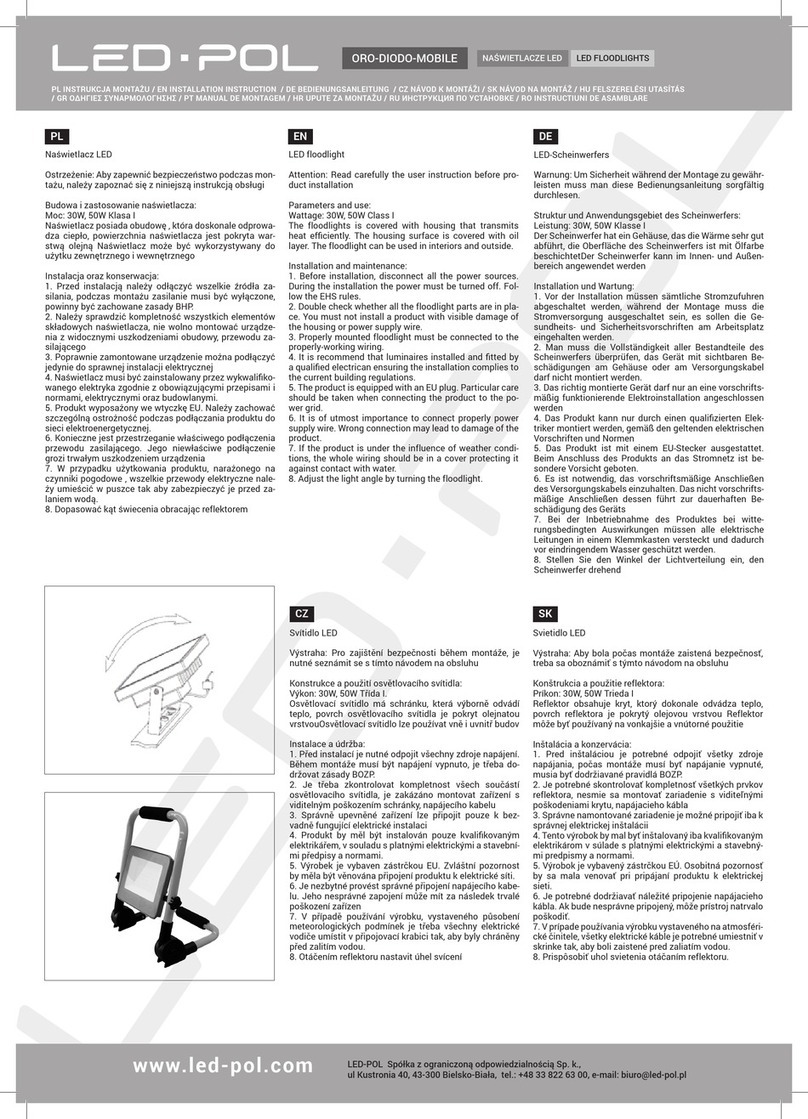
LED-POL
LED-POL ORO-DIODO-MOBILE Installation instruction
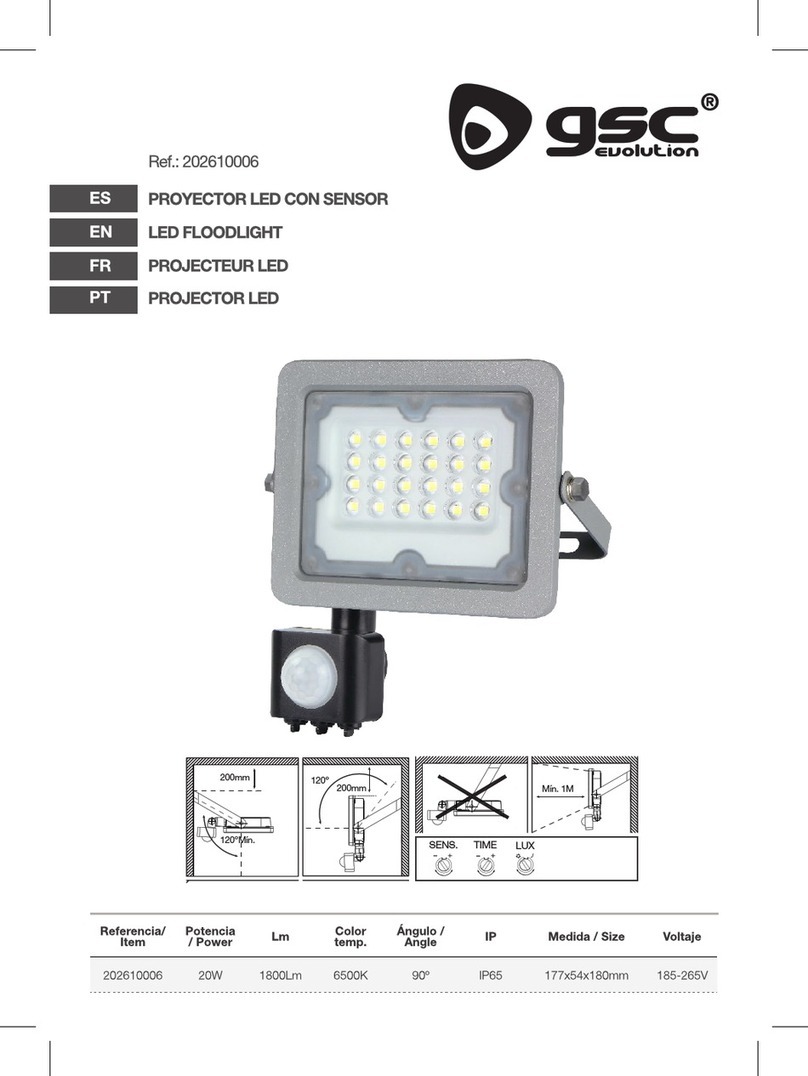
gsc evolution
gsc evolution 202610006 manual
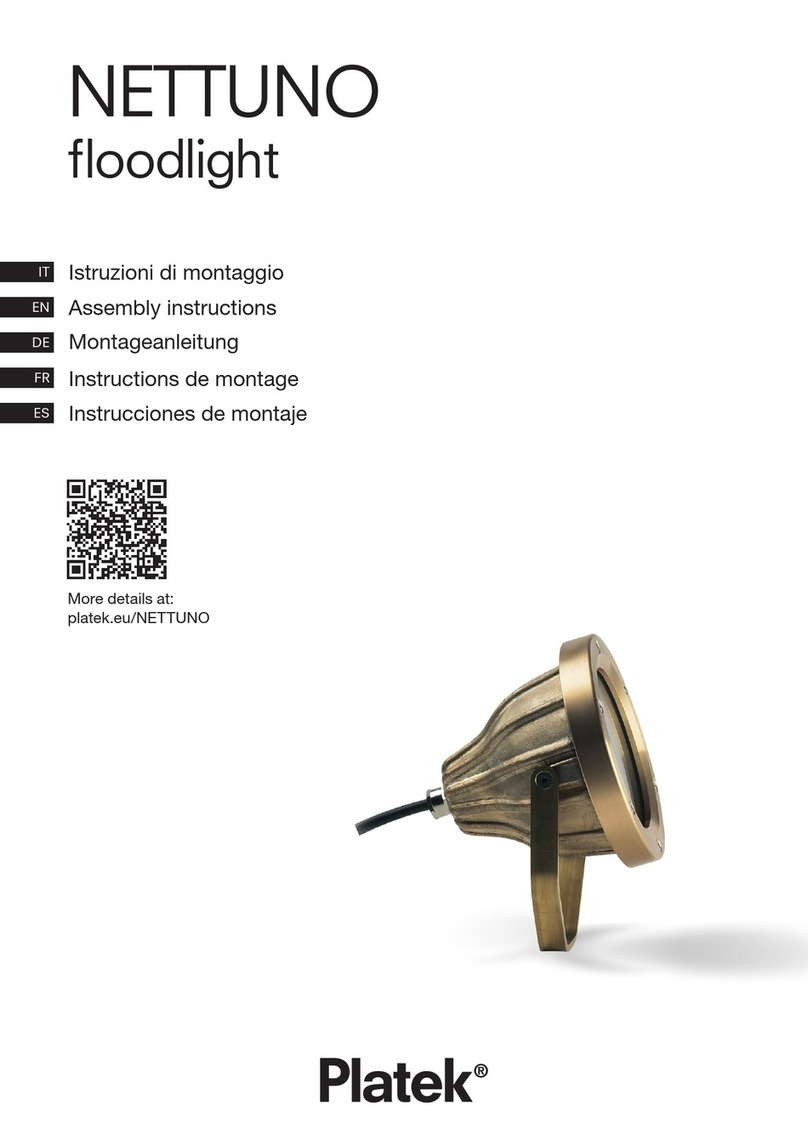
Platek
Platek NETTUNO PROIETTORE Assembly instructions

STEINEL
STEINEL HS 150 Series installation instructions
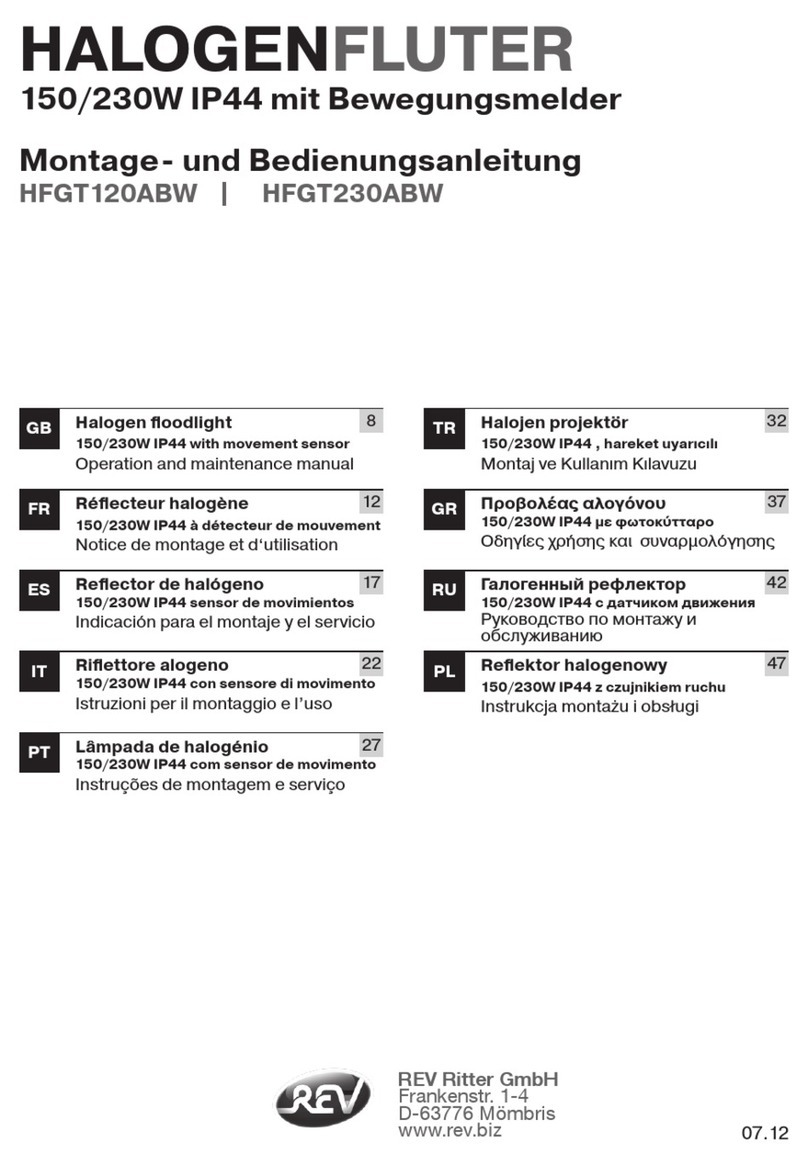
REV Ritter
REV Ritter HFGT120ABW Operation and maintenance manual

Future light
Future light OCC-36 K2 user manual
